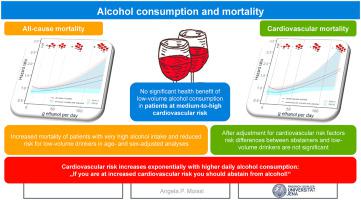Atherosclerosis ( IF 5.3 ) Pub Date : 2021-08-12 , DOI: 10.1016/j.atherosclerosis.2021.08.014 Angela P Moissl 1 , Graciela E Delgado 2 , Bernhard K Krämer 3 , Christine Dawczynski 4 , Tatjana Stojakovic 5 , Winfried März 6 , Marcus E Kleber 7 , Stefan Lorkowski 4

|
Background and aims
One of the most important risk factors for morbidity and mortality is the consumption of alcohol. The aim of our study was to examine the effect of alcohol consumption on all-cause mortality and cardiovascular mortality.
Methods
The Ludwigshafen Risk and Cardiovascular Health (LURIC) study includes 3316 patients hospitalized for coronary angiography at a tertiary care centre in Southwest Germany. Patients were followed-up for a median of 9.9 (range 0.1–11.9 years) years. Total mortality number in the follow-up period was 995, and the number of incident cases, i.e. cardiovascular death, was 622. Information on alcohol consumption assessed by self-report questionnaires was used to calculate intake in grams of ethanol per day. Associations of alcohol consumption with morbidity and mortality were analysed using Cox proportional hazards regression.
Results
We found significantly increased mortality for patients in the highest alcohol intake group age- and sex-adjusted (hazard ratio of 1.59 (95%CI, 0.93–2.72)) and a reduced risk for the group of low-volume drinkers (hazard ratio of 0.75 (95%CI, 0.65–0.86)). After adjustment for cardiovascular risk factors, the risk difference between abstainers and low-volume drinkers was not significant anymore.
Conclusions
In the LURIC study, the risk of overall mortality and cardiovascular mortality is significantly increased in study participants with very high alcohol consumption and slightly increased in total abstainers as compared to participants with low consumption in unadjusted analysis, replicating the well-known J-curve. Adjusting for cardiovascular risk factors rendered the risk decrease observed for low-volume drinkers insignificant. Therefore, our results do not show a significant health benefit of low-volume alcohol consumption in a cohort of patients at medium-to-high cardiovascular risk.
中文翻译:

饮酒和死亡率:路德维希港风险和心血管健康 (LURIC) 研究
背景和目标
发病率和死亡率的最重要风险因素之一是饮酒。我们研究的目的是检查饮酒对全因死亡率和心血管死亡率的影响。
方法
路德维希港风险与心血管健康 (LURIC) 研究包括 3316 名在德国西南部三级医疗中心住院接受冠状动脉造影术的患者。患者的中位随访时间为 9.9(范围 0.1-11.9 年)。随访期间的总死亡人数为 995,事件病例数,即心血管死亡人数为 622。通过自我报告问卷评估的酒精消费信息用于计算每天摄入的乙醇克数。使用 Cox 比例风险回归分析饮酒与发病率和死亡率的关联。
结果
我们发现,经年龄和性别调整的最高酒精摄入量组患者的死亡率显着增加(风险比为 1.59(95%CI,0.93-2.72)),而低量饮酒者组的风险降低(风险比为0.75 (95% CI, 0.65–0.86))。调整心血管危险因素后,戒酒者和少量饮酒者之间的风险差异不再显着。
结论
在 LURIC 研究中,与未经调整的分析中饮酒量低的参与者相比,饮酒量非常高的研究参与者的总体死亡率和心血管死亡率风险显着增加,而总体戒酒者的风险略有增加,复制了众所周知的 J 曲线。调整心血管危险因素后,观察到的低量饮酒者的风险降低不显着。因此,我们的研究结果并未显示在一组中高心血管风险患者中少量饮酒对健康有显着益处。



























 京公网安备 11010802027423号
京公网安备 11010802027423号